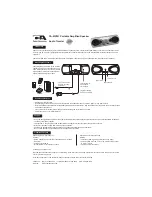
47
EN
NoticE
To stop the engine in an emergency, turn the generator switch to the OFF position.
10. LoW oiL sEcUritY
•
The oil sensor detects the fall in oil level in the crankcase and automatically stops the engine when the oil
level falls below a predetermined level.
•
When engine has stopped automatically, switch off generator’s no-fuse breaker, and check the oil level.
Refill engine oil to the upper level as instructed on page 9 and restart the engine.
NotE
If the engine doesn’t start by usual, consult your nearest Worms Entreprises dealer or service shop.
11. WAttAgE iNforMAtioN
Some appliances need a ‘‘surge’’ of energy when starting. This means that the amount of electrical
power needed to start the appliance may exceed the amount needed to maintain its use. Electrical
appliances and tools normally come with a label indicating voltage, cycles/Hz, amperage (amps) and
electrical power needed to run the appliance or tool. Check with your nearest dealer or service center
with questions regarding power surge of certain appliances or power tools.
•
Electrical loads such as incandescent lamps and hot plates require the same wattage to start as is
needed to maintain use.
•
Loads such as fluorescent lamps require 1.2 to 2 times the indicated wattage during start-up. gB 38
•
Loads for mercury lamps require 2 to 3 times the indicated wattage during start-up.
•
Electrical motors require a large starting current. Power requirements depend on the type of motor
and its use. Once enough ‘‘surge’’ is attained to start the motor, the appliance will require only 30%
to 50% of the wattage to continue running.
•
Most electrical tools require 1.2 to 3 times their wattage for running under load during use. For
example, a 5,000 watt generator can power a 1800 to 4000 watt electrical tool.
•
Loads such as submersible pumps and air compressors require a very large force to start. They need
3 to 5 times the normal running wattage in order to start. For example, a 5,000 watt generator would
only be able to drive a 1,000 to 1,700 watt pump.*
NoticE
The following wattage chart is general guide only. Refer to your specific appliance for correct wattage. To
determine the total wattage required to run a particular electrical appliance or tool, multiply the voltage
figure of the appliance/tool by the amperage (amps) figure of the same appliance / tool. The voltage and
amperage (amps) information can be found on a name plate which is normally attached to electrical
appliances and tools.












































